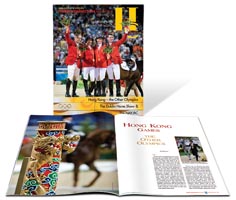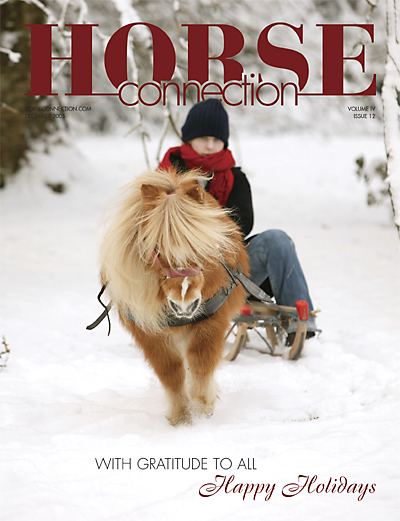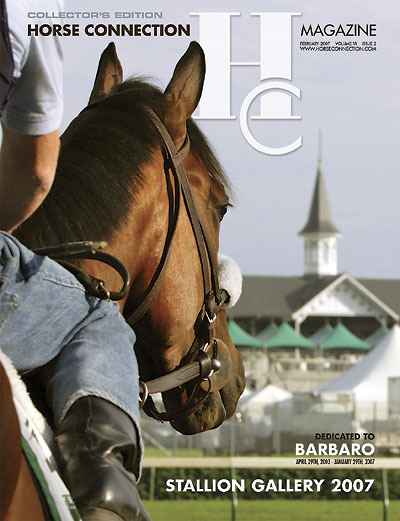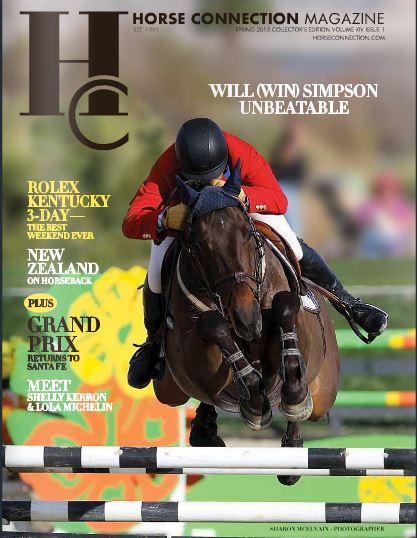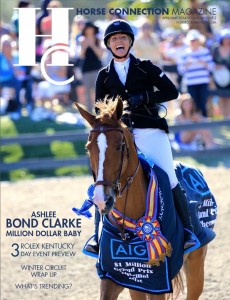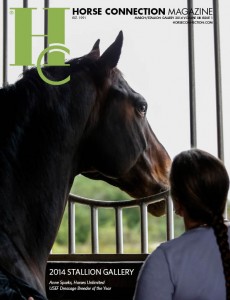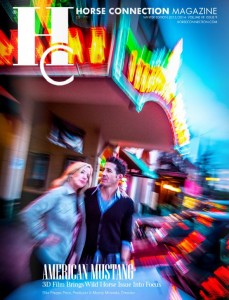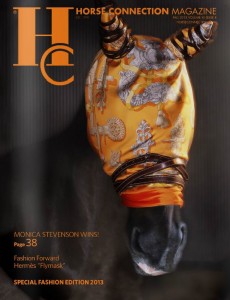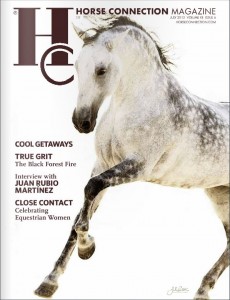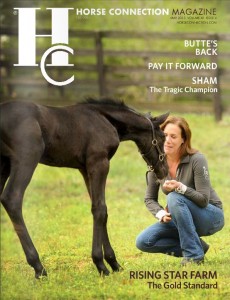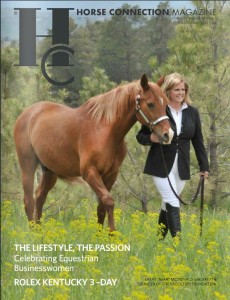
Creating Happy, Healthy Stallions – A look inside Hilltop Farm – February 2005
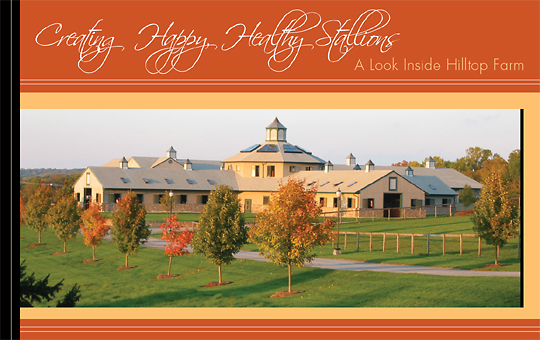
christine deherrera
There is nothing more magnificent than a stallion. With strong, arched neck, brilliant, expressive eyes and jaw dropping presence, it is the dream of many riders to possess their very own stallion. Unfortunately the dream can turn to disappointment and danger in the blink of an eye.
Not every farm or every rider is capable of helping a stallion reach his potential, either in the show ring or in the breeding shed. Without proper planning and handling, a stallion won’t be successful and may even become dangerous. However, isolated stalls and the severe use of stud chains through the mouth are mostly relics from yesteryear. Today, enlightened horsemanship has discovered a better way to treat stallions resulting in elevated performance.
Stallion vitality and enthusiasm are essential at Hilltop Farm in Colora, Maryland, where 300-400 breedings are handled each year. In this exclusive Horse Connection interview, Susanne Hassler, Breeding Manager at Hilltop, shares the nuts and bolts of their stallion program that result in happy, healthy breeding and performance stallions. Susanne’s knowledge of stallions is firsthand, not only as a handler, but also as a rider. In 2004, she made American history when she rode the Hanoverian stallion Royal Prince to fourth place at the FEI World Championships for Young Horses in Verden, Germany.
An American Dream
Fifteen years ago Jane MacElree and Scott Hassler embarked on a daring journey to create a sport horse breeding facility in the United States to rival the highest quality studs in Europe. Beginning with three stallions and six broodmares, their vision has grown to encompass some of the top sport horses in the world.
While there are too many accomplishments to list them all, a few highlights include Parabol’s selection for the short list for the 1994 Pan American Team, Riverman’s Grand Championship at Dressage at Devon in 1995, Rousseau’s victories at the 2002 PAVO Cup, the 2003 KWPN Stallion Show and the 2003 Silver Medal at the World Championship for Young Horses. In 2004, Contucci’s offspring swept Dressage at Devon by taking home the Filly Championship, Colt Championship, Young Horse Champion and Reserve, and the Reserve Grand Championship title.
With eight stallions in the United States, two stallions in Europe as well as guest stallions and frozen semen from several European stallions, Hilltop offers something for everyone. Among the most well known are Riverman, Rousseau, Parabol, Contucci and now Royal Prince. Dedicated not only to quality stallions and young horses, but also to helping educate American sport horse enthusiasts, Hilltop is at the forefront of the American breeding industry.
Stallion Selection
Essential to the farm’s success has been the careful evaluation and selection of stallion prospects, beginning with Cabaret and Nurejev. “We have to deeply believe in every stallion that comes into our program,” Susanne explains. Most of the Hilltop stallions will have a lifelong career in sport in addition to their breeding duties. The largest consideration in selecting a stallion is not his breed or his bloodlines, but rather his overall quality as an individual.
Rideability and character are “absolutely critical starting points,” Susanne says. “Most important is the stallion’s mind and his willingness to work. We are producing riding horses for sport so these qualities are of paramount importance.”
And of course, the horse must be physically talented. However, rather than solely specializing in dressage or jumping, Susanne believes it is important to assess the horse’s overall athletic ability. Horses destined for the jumper ring should still possess quality movement, while dressage horses must have the athletic ability and scope for jumping. The stallion must be an exceptional individual.
Breed is the least important consideration at Hilltop—Hanoverian, Westphalian, Holsteiner—are all represented at the farm. Naturally bloodlines are very influential, but the registration organization is not as critical in the American breeding program.
Stallion Friendly Environment
Of course top stallions will not stay that way for long if they are not cared for properly. Many people still believe that the secret to good stallion behavior is isolation. Unfortunately, the result of isolation is usually just the opposite of the desired behavior—an uncontrollable horse. It is important to remember that horses, including stallions, are herd animals and they thrive in a herd environment. At Hilltop, “The stallions have contact with each other,” Susanne says. “They can touch noses and even ‘love on each other’ through the bars. They are not walled off.”
However the stallions do live in a wing that is separate from the two training wings. This reduces the hustle and bustle that may disturb the stallions’ sensitive nature. Susanne explains, “Stallions are far more tuned in.”
The physical structure of the barn itself is also adequately prepared for stallions. The stalls are reinforced with rebar through the wooden slots in order to survive the physicality of the horses. The bars between the stalls are steel, which has been strong enough to survive 15 years of stallion behavior. Each stall has a window giving each horse “a room with a view.”
Daily turnout is part of the program at Hilltop. The stallion turnouts are 30 feet wide by 200 feet long– enough room to play, but not enough room to allow the running and playing to get too out of control, Susanne says. The stallion paddock’s fence lines are eight feet high, discouraging even the most talented jumpers. To prevent the stallions from getting overly exuberant during turnout, only every other run is used at any given time.
Clarity of Purpose
Most of the stallions at Hilltop do double duty—competitions and breeding. To help the stallions differentiate their work, the jobs are clearly separated. The living and training areas are separate from the breeding center. There is even a stallion handler that takes the horse to the breeding shed. “When they see Bud they are allowed to get a little excited. They know when they take a walk up the hill it is for breeding,” Susanne says.
Proper Handling
Regardless of whether preparing for breeding or work under saddle, Hilltop sets a very high standard for stallion handling. “You must command their attention and their respect,” Susanne says. This is not done through whips and chains, but rather by setting strict boundaries and clarity of what is acceptable behavior. She continues, “We want a relationship based on trust. We are very clear and very fair. Consistency on our part is critical.”
Even the working students can handle Hilltop’s stallions, but this only occurs after each new employee or student is taught how to make corrections and command respect. “Corrections are rooted on refocusing [the stallion’s] attention on us,” Susanne explains. There is also an equal amount of praise and pets for proper behavior. “We let the horse know it has done a good job, but we rarely feed treats by hand,” she says.
Routine for Health and Happiness
Everyone wants to have a healthy horse, but for a breeding stallion, good health is a requirement. Routine health care such as vaccinations, worming and a yearly physical exam are part of the program for the Hilltop stallions.
While it may be inconvenient for a rider to have a sick horse, a stallion with a fever that damages his sperm will need 60 days before the next batch of sperm have matured. To help lower the risk of exposure to viruses and bacteria, the stallion wing at Hilltop has a “no visitors” policy, meaning that training horses are not taken up and down the aisles or put into the stallion stalls. Although not strictly an isolation unit, this helps reduce exposure to little bugs.
Susanne believes that variety in each stallion’s work is critically important to his health and happiness. The stallions at Hilltop not only exercise in the dressage or jumping ring, but enjoy regular hacks, free schools and free jumping.
In addition, other controlled exercise is often part of the program. This can include walks or time on the horse walker. Susanne finds that the walker is extremely useful for the older horses because it improves circulation. The stallions at Hilltop also benefit from regular massage; “a therapeutic treat for our hard working boys,” she says.
This emphasis on health and happiness is imperative. A stallion must have plenty of energy for work and breeding. “Keeping him happy is the utmost priority,” Susanne says.
Horse Shows
While the environment at home is fairly easily controlled, the program is put to the test at a horse show. This more challenging atmosphere requires thoughtful planning. To ensure the safety of the stallions in the stalls, Hilltop brings siding to outfit the show stalls, which are often flimsy and may even have space between the slats. In addition, the stall doors are arranged so there is a full-length door on each stallion stall, so the jumpers are not tempted. The shows are the one place where no direct contact between horses is enforced.
To help the horses deal with the stimulation, a careful schooling program is followed. “We try to find a morning to school when the excitement is not quite peaking,” says Susanne. “We also take the stallions on walks under saddle around the show grounds. They need to see what is going on.”
Each stallion is different. Some become more excitable than others. Cabaret was so non-plussed by the show atmosphere that “ you could take him to the shows without even thinking about it,” Susanne says.
An ideal stallion environment coupled with expert handling has resulted in a proliferation of success for Hilltop’s stallions. With hundreds of blue ribbons and tri-colors from the world’s most prestigious shows, Hilltop Farm has proven that happy, healthy stallions succeed in the show ring, but also in the breeding shed.

